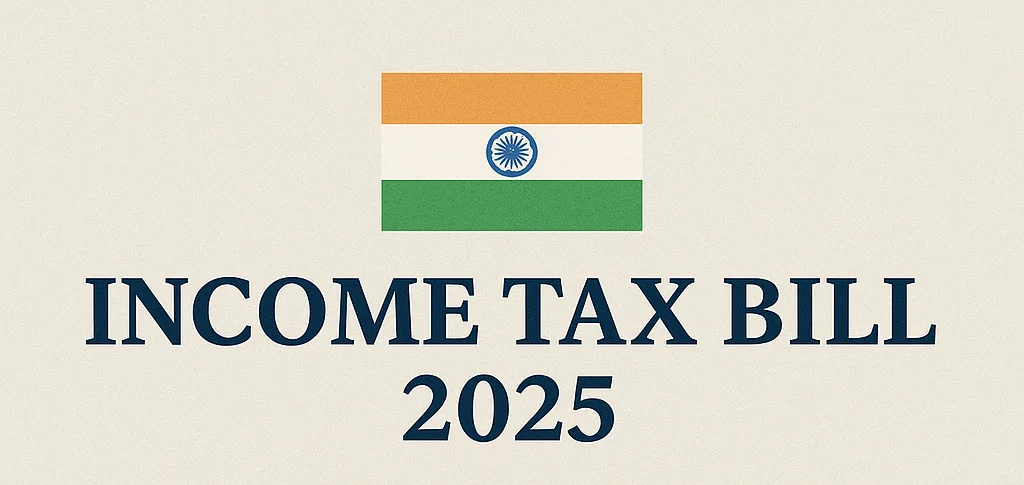Income Tax Bill 2025
The Income Tax Bill 2025 replaces the old Income Tax Act with a concise, reader-friendly, digital-ready regime—introducing a single “tax year”, simplifying refunds, and strengthening oversight over digital and global income.

Why is it in News?
In a historic shift, both houses of India’s Parliament have passed the Income Tax Bill 2025, replacing the antiquated Income Tax Act of 1961. This new legislation aims to simplify, modernize, and rationalize the tax system for the digital era. At a time when e-commerce, social media, and digital assets are reshaping the economy, the bill marks a decisive step towards comprehensive reform.
One standout feature is the bill’s broad definition of “virtual digital space,” encompassing emails, social media accounts, cloud storage, websites, and all forms of digital platforms. This expansion not only tightens oversight on digital incomes but also seeks to curb tax evasion using online channels.
The law empowers tax authorities with access to digital passwords and accounts in certain cases of suspected tax evasion or underreporting. While enhancing transparency and compliance, this aspect has sparked debate over privacy concerns and data protection.
Purpose and Significance
The central objective of the Income Tax Bill 2025 is to align India’s taxation regime with the realities of a digital-first economy. The previous system, framed in an era devoid of such technology, often failed to address challenges posed by cryptocurrencies, digital transactions, and global online incomes.
By introducing a uniform “tax year” (April 1 to March 31), the law eliminates the confusion created by the dual concepts of “assessment year” and “previous year,” making compliance much easier for taxpayers and tax professionals.
Another major relief is the removal of restrictions on refund eligibility based solely on timely filing of returns. Taxpayers who file late are no longer penalized by denied refunds, improving fairness and trust in the system.
Important Information
- Tax authorities now have extended powers for digital scrutiny, including access to emails, cloud accounts, social media, and more, in cases of investigation.
- “Tax year” replaces both “assessment year” and “previous year,” streamlining tax reporting and calculation.
- Refund procedures are made fairer; delayed filers are still entitled to their rightful claims.
- The bill addresses the rise of new-age income sources like cryptocurrency, online payments, and digital businesses with additional compliance norms.
- New safeguards are included for cybersecurity and privacy, with clear guidelines to prevent misuse of investigative powers.
Fact Table
| Aspect | Details |
|---|---|
| Bill Name | Income Tax Bill 2025 |
| Passed By | Both Houses of Parliament |
| Old Law | Income Tax Act 1961 |
| Main Objective | Simplification and modernization of tax law |
| New Concept | Single “tax year” (April 1 – March 31) |
| Digital Scope | Covers emails, websites, social media, cloud storage, etc. |
| Investigative Powers | Access to digital accounts in case of suspected evasion |
| Refund Reform | Time limits removed for claim eligibility |
| Implementation | On notification by the government |
Conclusion
The passage of the Income Tax Bill 2025 signifies India’s commitment to upgrading its fiscal infrastructure for the digital age. While easing compliance and broadening coverage, the bill also raises the standards for data security and taxpayer rights. Successful rollout and careful enforcement will be crucial for balancing transparency, privacy, and effective tax collection.
This reform advances India’s position as a modern economy, ready to handle new revenue streams and deter modern tax evasion strategies. It also underscores the importance of ongoing legal adaptation in an era of rapid technological change.
Key Facts
- Passed February 2025 for rollout in April 2026
- Replaces 1961 Act; cuts law complexity by ~50% (2.6 lakh vs. 5.1 lakh words)
- Streamlined: 536 sections (down from 819), 23 chapters (was 47)
- “Tax year” (April–March) standardizes reporting (replaces assessment/previous year)
- Refunds allowed regardless of late filing—improving fairness and compliance
- Digital assets, crypto, websites, social media, emails, and cloud are all covered for taxability
- Simplified language: removed 1,200 provisos, 900 explanations, archaic phrases replaced
- Tax slabs remain: NIL (up to ₹4 lakh), 5% (₹4–8L), 10% (₹8–12L), 15% (₹12–16L), 20% (₹16–20L), 25% (₹20–24L), 30% (above ₹24L)
UPSC Practice Questions
- Assess the implications of the Income Tax Bill 2025 for India’s tax administration and taxpayer convenience.
- Analyze the challenges posed by the digital economy for tax compliance, and how new legislation addresses them.
- Critically discuss the balance between investigative powers and privacy rights in the context of the new tax regime.
- Suggest strategies for increasing tax compliance and revenue collection while maintaining a taxpayer-friendly approach.
